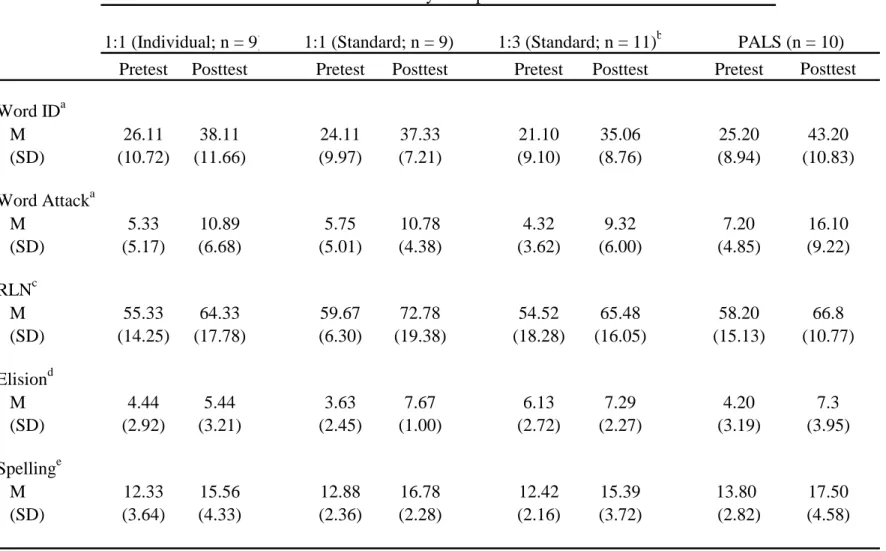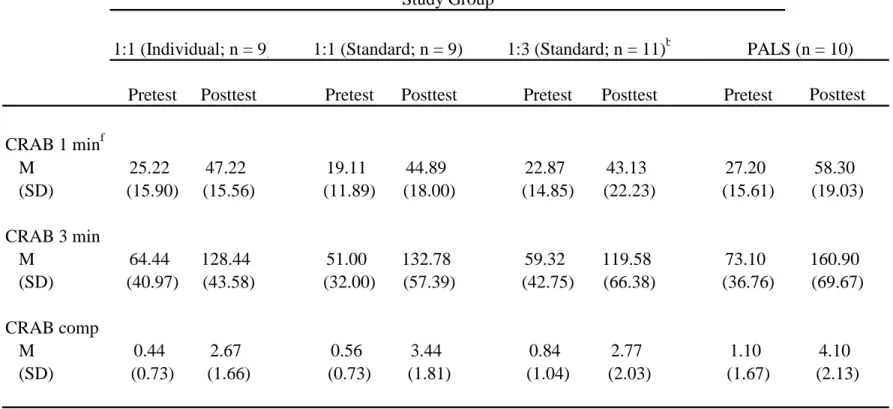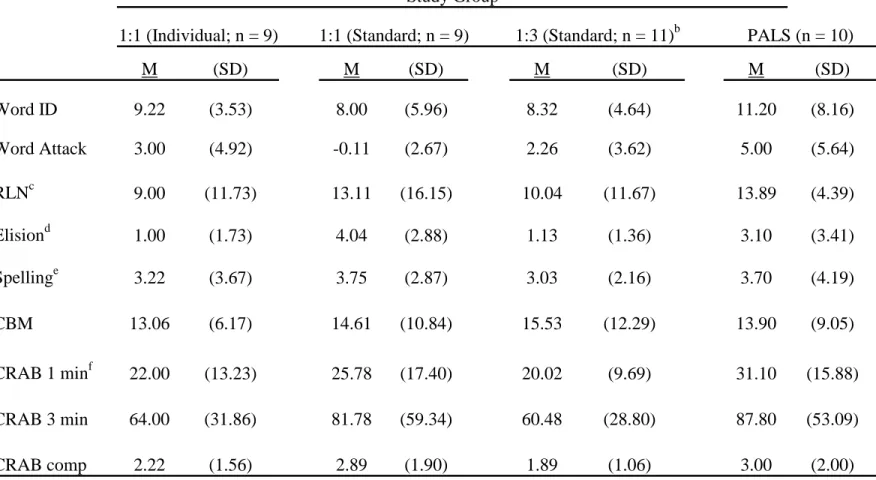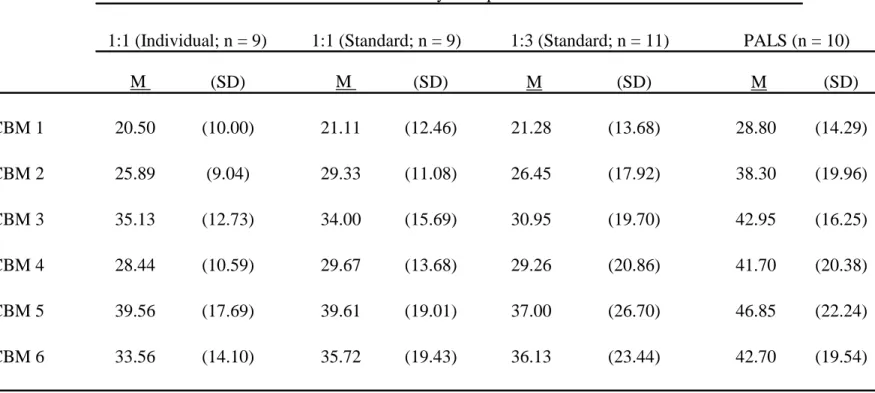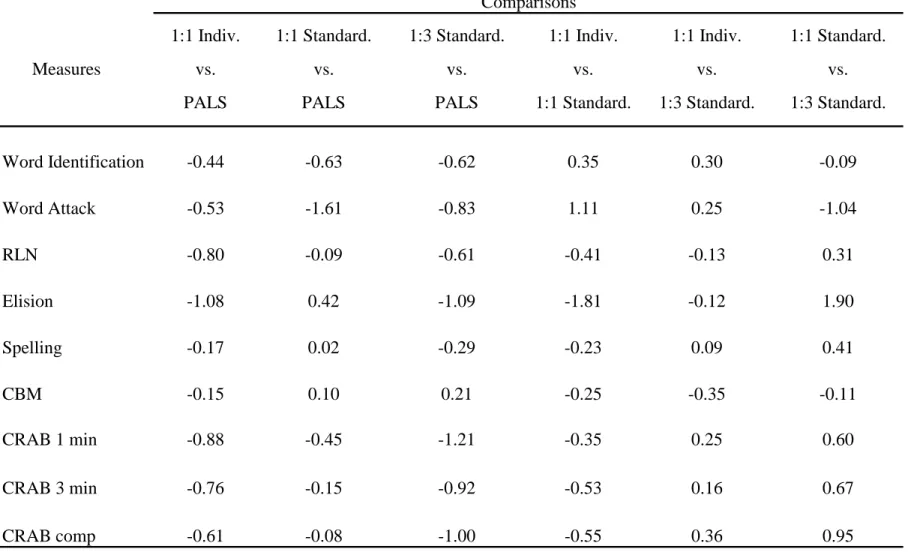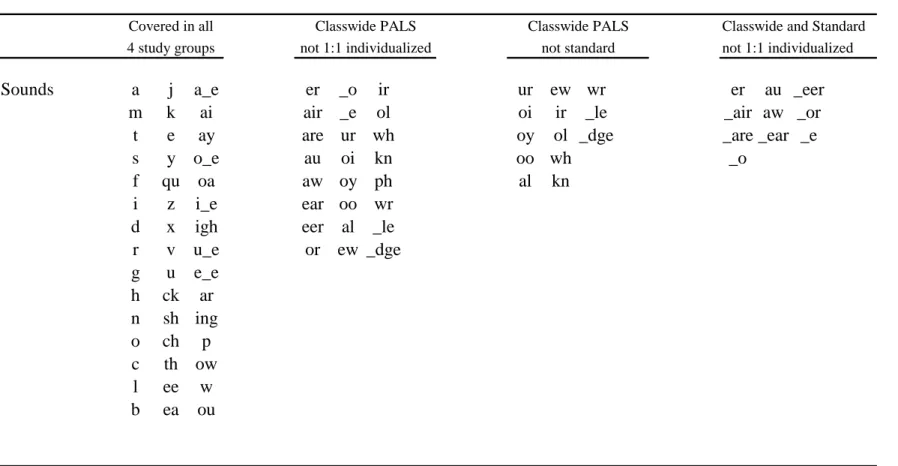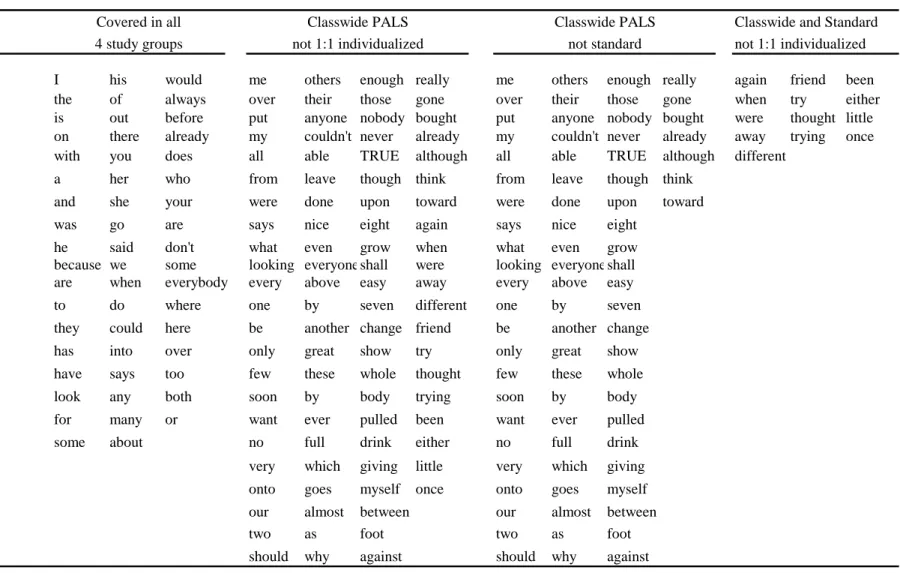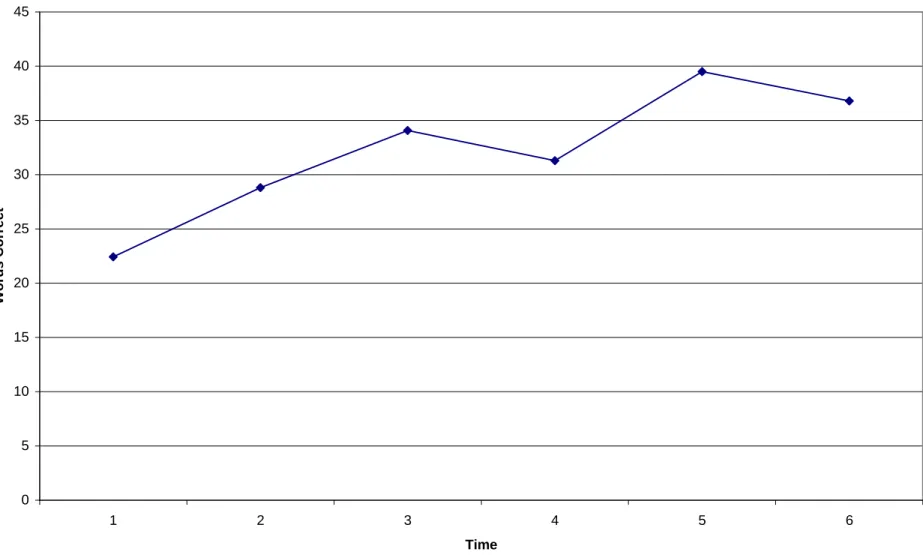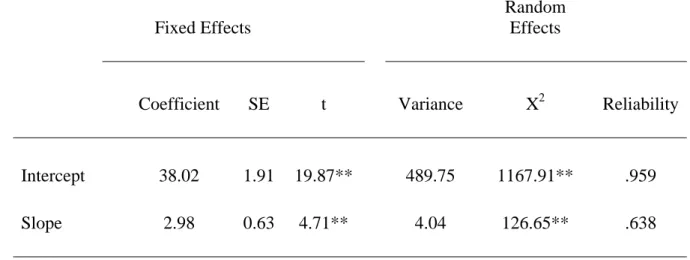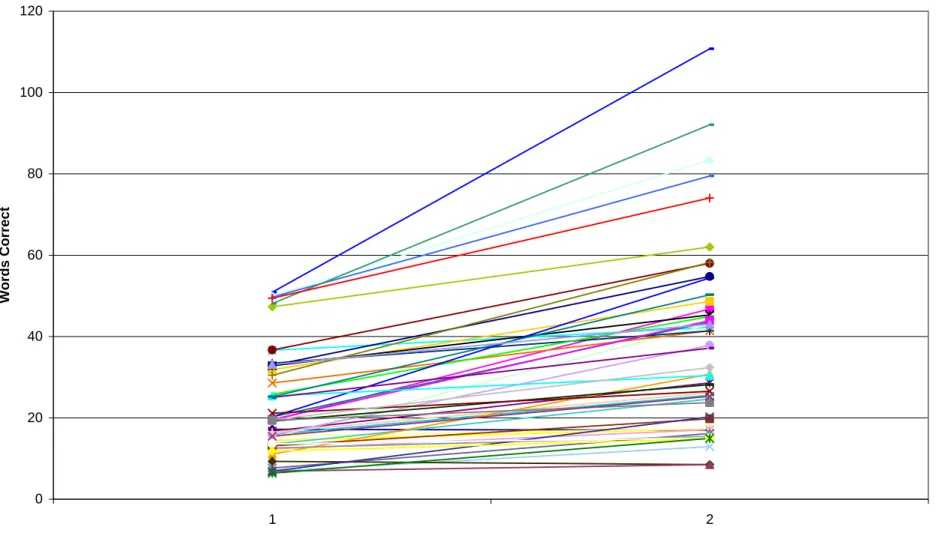THE EFFECTS OF GROUP SIZE ON READING OUTCOMES OF IDENTIFIED NONRESPONDERS
By
Caresa Lynn Young
Dissertation
Submitted to the Faculty of the Graduate School of Vanderbilt University
in partial fulfillment of the requirements for the degree of
DOCTOR OF PHILOSOPHY in
Special Education May, 2008 Nashville, Tennessee
Approved
Professor Douglas Fuchs Professor Lynn Fuchs Professor Donald Compton
Professor Kathleen Lane Professor Daniel Ashmead
Copyright © 2008 by Caresa Lynn Young All Rights Reserved
ACKNOWLEDGMENTS
I would like to thank my wonderful family and friends for all of your support.
Mike, Mom, Dad, Candy, and David: You have all been there for me during this entire process cheering me along, nudging me along, and supporting all the other life events that can sometimes get in the way. For my children, Tyler and Jenna, you are my inspiration and my hope for the future. I love you all.
My sincere appreciation to my advisor, Doug Fuchs, who never gave up on me and has given me so many wonderful opportunities. I have learned so much from him and his work. Also, to my entire committee for your wonderful suggestions.
TABLE OF CONTENTS
Page
ACKNOWLDEGMENTS ... iii
LIST OF TABLES ... vi
LIST OF FIGURES ... viii
Chapter I. INTRODUCTION ...1
Treatment Nonresponders ...1
Increasing Responsiveness to Reading Instruction ...4
Purpose ...7
Importance ...8
II. LITERATURE REVIEW ...9
Rationale for the Importance of Research on Grouping Arrangements For Instruction ...9
Literature Search ...10
Findings...11
Implications for Further Research ...33
III. METHODS ...35
Participants ...35
Treatment ...42
Measures ...48
Procedures ...53
Data Analysis ...58
IV. RESULTS ...59
Descriptive Information ...59
Effect Sizes ...63
Post Hoc Analysis ...67
Growth Model of CBM ...71
V. DISCUSSION ...79
Study Group Differences ...79
Study Limitations ...84
Conclusions and Implications ...85
Future Analyses ...97
Appendix A. Scope and Sequence of Tutoring Activities ...89
REFERENCES ...93
LIST OF TABLES
Table Page 1. Methodological Information for Meta-Analyses and Narrative Reviews on 1:1
Instruction ...13
2. Relevant Findings for Meta-Analyses and Narrative Reviews on 1:1 Instruction ...14
3. Methodological Information for Meta-Analyses and Narrative Reviews on Small Group Instruction ...19
4. Relevant Findings for Meta-Analyses and Narrative Reviews on Small Groups ...20
5. Methodological Information for Meta-Analyses and Narrative Reviews of 1:1 Versus Small-Group Instruction ...24
6. Relevant Findings for Meta-Analyses and Narrative Reviews of 1:1 Versus Small-Group Instruction ...25
7. Number of Groups (and Students) by Tutoring Group and PALS Treatment ...38
8. Number of Groups (and Students) by Tutoring Group Placed in Each Type of School ...38
9. Number of Students in each Tutoring Group by School ...40
10. Descriptive Statistics for Monitoring Measures (October to December) by Tutoring Group ...41
11. Time Spent on Each Tutoring Activity ...43
12. Pre and Post-Treatment Reading Raw Scores by Study Group ...60
13. Average Improvement of Nonresponsive Students by Study Group ...62
14. Number of Words Correct Per Minute on CBM Measures ...64
15. Effect Sizes on Reading Measures ...65
16. Comparison of Sound Coverage in Each Study Group ...69
18. Unconditional Linear Growth Models for CBM ...74 19. Conditional Linear Growth Models for CBM ...77
LIST OF FIGURES
Figure Page 1. Mean Performance at Each CBM Assessment ...72
2. Individual CBM Growth Trajectories ...75 3. Growth of ELL Versus Non-ELL Students ...78
CHAPTER I
INTRODUCTION
Students with specific learning disabilities comprise 47% of the placements in special education, with reading disabilities being the most common classification (Lyon, 1995). Much research has focused on remediating reading deficits in young students because researchers have documented the long-term negative consequences of early reading failure (e.g., Juel, 1988). In 1998, a panel of reading experts published a report that synthesized the available research in reading (National Reading Panel, 1998). The report claimed that the best reading instruction included direct, systematic instruction in phonemic awareness, phonics, fluency, vocabulary, and reading comprehension. These essential skills have been termed the building blocks of reading (Center for the
Improvement of Early Reading Achievement, 2001). Intervention studies (e.g.
Blachman, Ball, Black, & Tangel, 1994; Foorman, Francis, Fletcher, & Schatschneider, 1998; Torgesen, Alexander, Wagner, Rashotte, Voeller, and Conway, 2001) have found that teaching these building blocks of reading can significantly increase students’
phonological awareness skills and word recognition skills.
Treatment Nonresponders
Many students nevertheless do not respond to generally effective reading
instruction (e.g., Vellutino, Scanlon, Sipay, et al., 1996). Approximately 50% of students with disabilities (e.g., Fuchs, Fuchs, Thompson, Al Otaiba et al., 2001; Torgesen, 2000),
and 20% to 30% of students at-risk for reading failure, do not benefit from best practices in reading instruction (e.g., Al Otaiba & Fuchs, 2002; Blachman, et al., 1994; Mathes, Howard, Allen, & Fuchs, 1998). This translates to approximately 2-6% of the total school population. These students are typically referred to as “nonresponders.”
With the President’s signing of the No Child Left Behind legislation (2002), these findings are troublesome to advocates, practitioners, researchers, and policy makers.
Funding has increased for additional research on how to identify and treat nonresponders, which has led to national concern over current methods of LD identification. Specifically, the IQ-achievement discrepancy model has been widely criticized on several fronts (see Kavale, 2002 for a full review). Most notably, critics say, students are not identified for special education services until they have already experienced long-term failure in the general education classroom. Some have proposed a new identification procedure that includes three tiers of identification. In tier I, all students’ performance is monitored in general education. In tier II, group instruction is provided to those unresponsive to classroom instruction, and their performance at this second tier is monitored. Finally, tier III, would be special education placement. The final tier would be reserved for the children unresponsive to instruction at tiers I and II; that is, chronically unresponsive students. It is important for the policy makers, researchers, school administrators, and school teachers to understand the characteristics of nonresponders, the definition of nonresponsiveness, and how to best educate these students.
Study of nonresponders has had several dimensions. First, characteristics of nonresponders have been examined (Al Otaiba & Fuchs, 2002; Torgesen & Davis, 1996;
intervention as well as better intervention plans for these students. Students could be identified earlier as being at-risk for reading failure and placed in appropriate research- based interventions.
Second, researchers are studying how best to define nonresponsiveness to treatment. Togesen et al. (2001), for example, defines nonresponsiveness as scoring below 90 on a standardized test. This is a stringent criterion. It is difficult to increase students’ standard scores because they are being compared to their peer group, which is always improving more or less. Therefore, to close the gap between targeted students and peers the targeted students must make relatively large gains. To say that students one standard deviation below the mean prior to intervention are “nonresponsive” to a treatment because their performance is unequal to the group mean at posttest is likely to be insensitive to whether growth may have occurred. If one considers that a student must make progress to maintain a standard score, it would seem to make little sense to expect students with disabilities to be “average” after intervention.
As an alternative to Torgesen’s definition of nonresponsiveness, Fuchs, Fuchs, and Speece (2002) have suggested use of a dual discrepancy model. Students are
identified as nonresponsive using both the slope and level of reading achievement using curriculum-based measures (CBM). This model accounts for how low the student’s achievement is at a point in time as well as growth of skills over time. Moreover, CBM is a reliable and valid measure of student progress. The dual-discrepancy method eliminates several serious problems with current methods of nonresponder identification. But it still does not answer the question; What level and how much growth is desirable? Criteria for performance level and growth are still arbitrary.
A third line of research has focused on determining ways to bolster effectiveness of reading programs for children not responsive to effective teaching strategies. While the National Reading Panel Report (1998) documented best practices in reading, the focus has shifted to what elements of intervention (i.e., pacing, intensity, duration, group size, expertise of the instructor) can increase student responsiveness.
Increasing Responsiveness to Reading Instruction
Group Size
Grouping for reading instruction has been a major area of contention in the field of education. In the 1960’s and 1970’s, students were often placed in small groups with other children who were at a similar instructional level. More recently, students are placed in multiple-ability groups (Schumm, Moody, & Vaughn, 2000). The rationale behind this shift from homogeneous grouping to heterogeneous grouping has been to prevent low self-esteem in students in low-achieving groups and to provide good reading models for the poor readers. The inclusion movement (placing students with disabilities in the general education classroom) has also decreased homogeneous grouping and increased heterogeneous grouping.
Moody, Vaughn, and Schumm (1997) interviewed general and special education teachers to determine their grouping practices. They found that general education
teachers typically relied on whole-class instruction. In contrast, special education teachers typically grouped students based on their developmental level. Elbaum, Schumm, and
determine how they felt about grouping. Overall, students said that participating in multiple-ability groups was more beneficial than whole-class instruction or homogeneous grouping.
Surprisingly little research has been conducted to explore possible differential effects of group size (e.g., whole class instruction vs. small groups of three to five
children vs. individual instruction) on students’ reading performance. Whereas intensive, individualized instruction has been shown to remediate severe reading deficits of many children (e.g., Torgesen, Wagner, Rashotte, & Herron, 1999), scant resources in schools often make individualized programs uneconomical and infeasible. That is, whereas Torgesen et al. (1999) provided instruction 4 days a week for 2.5 years for all at-risk students in one district, special education in most districts provide little, if any,
individualized instruction (Vaughn, Moody & Schumm, 1998). According to Vaughn et al., most special education instruction is provided in groups of 5 to 19 students.
Although it is widely assumed that 1:1 intervention is superior to small group direct instruction, little research has systematically been conducted to test this belief. In fact, the National Reading Panel (1998) found that 1:3 instruction may be as effective as 1:1 instruction if students are on the same developmental reading level. Elbaum, Vaughn, Hughes, and Moody (1999) conducted a meta-analytic review to determine the grouping practices that had the best academic outcomes for students with disabilities. They found that students in small groups or in peer tutoring made impressive gains in decoding, suggesting that small group instruction may be as effective as individual tutoring. Peer tutoring, they pointed out, can be used with an entire class (e.g., classwide peer tutoring), limiting the amount of teacher time and resources needed. However, the researchers of
the work included in Elbaum et al’s meta-analysis did not directly compare effects of small group instruction to 1:1 instruction in the same experimental design. The research studies were reviewed separately and conclusions were drawn based on effect sizes, not direct comparisons.
Thurlow, Ysseldyke, Wortuba, & Algozzine (1993) conducted a descriptive study of small groups. She examined how eight variables were affected by different grouping formats. For students in 1:1 tutoring, there were no differences in academic responding time, academic engagement time, task management, or inappropriate behavior when compared to students in 1:3 tutoring. However, as group size increased beyond three students, 1:1 instruction was superior. An obvious inference is that students will perform equally well in a group of three as in 1:1 tutoring. However, Thurlow, like Elbaum et al.
(1999), did not directly examine the differences in academic outcomes of students in small groups versus individual tutoring.
Standardized Versus Individualize Instruction
Another major issue in increasing responsiveness to intervention is the extent to which academic materials must be individualized for each student. Large-scale research studies (e.g., Torgesen et al., 1999) typically implement comprehensive and standardized tutoring packages that are, by definition, the same for all the participants. What is not clear is the extent to which materials should be modified to meet the needs of individual students. No studies could be found that directly examined this issue despite apparently important implications. If standard and individualized approaches were found equally
would be easier to implement. That is, teachers and/or tutors could be trained on a set of tutoring materials and they would implement these for all struggling readers.
Individualizing instruction, by contrast, requires extensive training in reading methods, recognizing when progress is not being made, and modifying instruction in reasonable ways. In addition, effective individualized tutoring depends a great deal on rigorous training, professional experience, and clinical judgment. A standardized tutoring
program reduces the amount of training, experience, and judgment required to implement the program.
Purpose
The purpose of this study was to involve second-graders unresponsive to
research-validated classroom instruction (i.e., Peer Assisted Learning Strategies; PALS) in four treatments: one to one standardized, one to one individualized, one to three standardized, and continuation in large-class PALS. The research questions were: (a) Does individualizing tutoring promote greater reading growth than a standardized approach? (b) Do students in standard 1:1 instruction show greater improvement than those in small group standard instruction? Students’ reading ability in class-wide PALS was monitored to identify those who were not responding to the PALS program.
Nonresponders were identified as dually (level and slope) discrepant. They were assigned randomly to individualized 1:1 tutoring, standardized 1:1 tutoring, and standardized 1:3 tutoring. Or they were chosen randomly to remain in the PALS class-wide program.
Nonresponders were monitored weekly to determine which method of instruction increased the reading performance. Thus this research explores the importance of group
size (1:1 versus 1:3) and standardized instruction versus individualized instruction in terms of students’ reading growth.
Importance
Whereas teams of researchers have documented the efficacy of small group instruction for students with disabilities (e.g., Elbaum et al., 1999; Moody et al., 1997), there has not been experimental study of how well small groups work for students unresponsive to research-based, generally effective instruction. In addition, there has been no direct comparison between 1:1 tutoring and 1:3 tutoring. If small-group tutoring is as effective as 1:1 tutoring, special education resources could potentially be used more efficiently to support instruction in small groups. This study may also shed light on whether individualized and standardized tutoring are equally effective for students who are nonresponsive to classwide instruction. Standardized instruction requires much less training, experience, and judgment thereby reducing costs for teacher training.
This study also incorporates several desirable methodological components.
Random assignment was used to place students in treatment groups. Treatments represented practices validated as effective for many at-risk students. Fidelity of treatment implementation was established for all study groups. Identification of nonresponders was based on a dual discrepancy model (i.e., level and slope of reading scores were taken into account). That is emerging as a valid index of nonresponsiveness (e.g., Fuchs, Fuchs, & Compton, 2004).
CHAPTER II
LITERATURE REVIEW
This chapter reviews the literature in which researchers have compared different grouping practices for students with and without disabilities to determine most effective instructional arrangements. First, a rationale for the importance of this topic is provided.
Second, methods of the literature search will be defined. Finally, findings of the literature search will be described, organized in terms of (a) meta-analyses and prior non-
quantitative reviews of the effects of 1:1 instruction, (b) meta-analyses and prior reviews of small-group instruction, (c) meta-analyses and prior reviews of 1:1 versus small-group instruction, and (d) studies in which researchers directly compared 1:1 and small- group instruction. Finally, implications for future research are provided.
Rationale for the Importance of Research on Grouping Arrangements for Instruction Determining the most effective interventions for students at risk of reading failure and those with reading disabilities has constituted a large part of the research in the past two decades. A systematic review of this literature by the National Reading Panel (1998) highlighted the components of effective reading instruction. These components were phonemic awareness, decoding, vocabulary, comprehension, and fluency instruction.
However, with the implementation of the policy of inclusion, many students with reading disabilities are being served in the general education classroom. Classroom teachers must
meet the particular needs of all their students. The question becomes, what is the best way to meet students’ needs who experience serious reading difficultie. Do students require one to one instruction to be successful? Are small-group arrangements as
effective as 1:1 instruction? Are there classwide methods as effective as 1:1 instruction or small-group instruction? These questions are very important because schools generally have very limited resources, and they are understandably interested in identifying effective instructional procedures that are also economical. In addition, as the nation moves toward using Response-To-Instruction as the means of providing early intervention and identifying students with learning disabilities, there is a need to determine if Tier 2 intervention (i.e., group instruction) is differentially effective than Tier 3 intervention (i.e., 1:1 instruction in special education).
Literature Search
Inclusion Criteria and Search Strategies
Published and unpublished scholarly articles were selected using four criteria.
First, the articles described interventions targeting reading skills. Second, study outcomes included reading measures. Third, study participants were at-risk for reading disabilities or had a documented reading disability. Fourth, the studies either reviewed the literature on different grouping formats or directly compared small group versus one to one instruction.
The literature search was conducted in the following way. The terms learning
group instruction, one to one instruction, and whole class instruction were entered into a computer search using Educational Resources Information Center (ERIC) from 1966- 2004; Psych Lit from 1967-2004; and Exceptional Child Educational Resources (ECER) from 1969-2004. Second, the abstracts produced by this search were reviewed to
determine which articles met the inclusion criteria. Third, articles were obtained and their respective reference sections were examined for other articles that were likely to meet the inclusion criteria. Finally, a manual search was conducted of the following journals from January, 1980, to December, 2004: Journal of Educational Psychology, Journal of Experimental Child Psychology, Journal of Learning Disabilities, Journal of Special Education, Learning Disabilities Research and Practice, Reading Research Quarterly, Remedial and Special Education, and Scientific Studies of Reading. If the title of an article indicated that the study involved a reading intervention, the abstract was read to determine its usefulness for this review. As a result of this entire search, 12 articles were identified. These articles are signified by asterisks in the reference section.
Results
Meta-Analyses and Reviews of One-to-One Instruction
Table 1 provides methodological information for all meta-analyses and narrative reviews of 1:1 instruction. Table 2 summarizes the relevant findings.
Elbaum, Vaughn, Hughes, Moody, & Schumm (2000) conducted a meta-analysis to determine the effectiveness of 1:1 instruction for students at-risk of reading failure.
Thirty one studies were reviewed and analyzed to answer the following questions: (a) how effective is 1:1 instruction for children at-risk of reading failure, (b) what features of the intervention relate to intervention outcomes, (c) what research methodologies are associated with intervention outcomes, (d) how does Reading Recovery compare to other interventions, and (e) how does 1:1 instruction outcomes compare to small group
intervention outcomes? The first three questions are most relevant here. The last two questions will be addressed later.
Elbaum et al. (2000) reviewed 31 studies which were published between 1975 and 1998. Participants were at-risk of reading failure or they had a diagnosed learning
disability. A majority of participants across the studies were first graders (N=1164).
There were 182 second and third graders, 130 fourth through sixth graders, and 63 first through fourth graders. There were a total of 216 ES comparisons. ESs ranged from -1.32 to 3.34. The authors then looked at seven variables to determine what mediated the instructional effectiveness. The variables included qualifications of instructors, tutor training, students’ grade level, focus of intervention, outcome measures, intensity of the intervention, and treatment fidelity. Results indicated that college students were the most effective tutors (d = 1.65), followed by paraprofessionals (d = .68), teachers (d = .36), and volunteers (d = .26). Tutors’ training was important. The ES for trained tutors was .59; 0.17 for untrained tutors. ESs for studies with and without fidelity of treatment were 0.85 and .06, respectively.
Students in grades 1-3 made statistically significant gains in 1:1 instruction (d = 0.37 to 0.49), whereas those in grades 4-6 did not make reliable gains. Students in
Table 1
Methodological Information for Meta-Analyses and Narrative Reviews on 1:1 Instruction
Citation Number of
studies
Grade level Risk Status Inclusion Criteria Inter-rater Agreement for Inclusion Criteria
Elbaum et al.
(2000) *
31 1-6 at risk and LD
1. published or available between 1975 and 1998 2. participants scored in lowest
20-30 percentile on reading tests or labeled LD
3. outcomes compared to comparable students who did not receive 1:1 instruction 4. outcome data could be
converted to effect sizes
not reported
Wasik & Slavin (1993)
16 1 at risk
not reported
Table 2
Relevant Findings for Meta-analyses and Narrative Reviews on 1:1 Instruction
Citation Dependent Variable(s) Effect Size
Meta-analyses and Narrative Reviews
Elbaum et al.
(2000)
Instructor 0.40-1.91
Grade Level
1 0.59
2-3 0.71
4-6 1.06
Dependent Measure 0.10-1.55
Intervention Duration
Up to 20 weeks 0.77
Over 20 weeks 0.57
Wasik & Slavin (1993)
Reading Recovery 0.49-1.50
Success for All 0.42-1.34
Prevention of Learning Disabilities 0.85-1.39
Wallach Tutoring Program 0.64-0.75
Programmed Tutorial 0.18-0.78
by interventions that included both decoding and comprehension (d = .50), decoding and word recognition (d = .44), and phonemic awareness intervention (d = 0.43).
Interventions focusing on visual perceptual skills were associated with statistically non- significant ESs near zero. The outcome measures used in each study yielded the
following ESs: Writing vocabulary, .94; listening comprehension, .68; decoding, .41 to .54; reading comprehension, .28; spelling, .14; and phonemic awareness, -.29.
Standardized tests yielded smaller ESs (d = .53) than did non-standardized measures (d = .62). The average ES for interventions lasting up to 20 weeks was .65; whereas ES for those with a duration greater than 20 weeks was .37. The authors found that the same amount of instructional time delivered more intensively has more powerful effects.
In sum, Elbaum et al. (2000) found that college students were the most effective tutors, trained tutors were more effective than untrained tutors, and implementing interventions correctly is important. Younger students made more significant gains than older students. Reading comprehension interventions were more effective than decoding and word recognition interventions. And finally, non-standardized measures yielded greater effect sizes than standardized measures.
Wasik and Slavin (1993) conducted a best evidence synthesis of five 1:1 reading programs to determine their success in preventing early reading failure among graders.
The reading programs were Reading Recovery, Success for All, Prevention of Learning Disabilities, Wallach Tutoring Program, and Programmed Tutorial Reading. Sixteen studies met Wasik and Slavin’s inclusion criteria.
For Reading Recovery, the authors reviewed two longitudinal studies conducted by the Ohio State group and two other primary studies. In the first longitudinal study,
Reading Recovery was compared to general education instruction or Title I pull out for the lowest 20% of first graders in the schools. Students in the Reading Recovery group outperformed those in Title I small groups and those in the general education classroom on all measures except letter identification and word recognition. At the end of the year, the ES was .72 which diminished at 1 year follow up (.29) and lessened further at 2 year follow up (.14). In the second longitudinal study, students in Reading Recovery were compared to those in the general education classroom. At the end of the implementation year, the ES was .78 versus .46 at 1 year follow up and versus .25 at the 2 year follow up.
However, 27% of the students were still performing below average at the end of the two year follow up. Moreover, these findings in favor of Reading Recovery should be taken with a grain of salt because the measurements were text-level reading assessments that directly correlated to what was taught in the reading program. In two other studies conducted by the Ohio State group to evaluate Reading Recovery, similar results were found. The ES at the end of the first year was .35 for dictation and .75 for text reading level.
The second program reviewed by Wasik and Slavin (1993) was Success for All.
Like Reading Recovery, it focuses on teaching reading in context but also adds a word attack component. Tutoring was continued as long as the student needed it: Some
students were tutored for 8 weeks; others for an entire year. This is different than Reading Recovery in which students were discontinued after 60 lessons regardless of whether they had made sufficient gains. Tutored students were in grades 1-3 and scored in the lowest 25% on the WRMT-R Letter-Word Identification and Word Attack subtest. The
year 1 was 1.01 for the first graders. The measures were letter word identification, word attack, oral reading and silent reading. The ES was 2.37 for year 2, .84 for year 3, and 1.83 for year 4. Similar results were found for students in grades 2 and 3.
The third program reviewed by Wasik and Slavin (1993) was the Prevention of Learning Disabilities. It differs significantly from the previous two programs in that there is very little reading for meaning. Students are taught word attack skills based on learning letter sounds. However, there is also no systematic phonics instruction. Students in grades 1-3 received instruction for two years, 3 to 5 days a week, 30 minutes per day. ESs
indicated a significant increase in oral reading (d = .85), word identification (d = .94) and word attack (d = 1.39) when compared to no treatment controls. However, ESs were smaller when compared to other 1:1 treatment phonics-related programs.
The Wallach Tutoring Program was the fourth reviewed program. At-risk students received tutoring for one full year, 30 minutes per day. The program is very similar to Success for All in that it teaches reading in connected text as well as phonics rules.
However, paraprofessionals are tutors instead of trained teachers. In two research studies, moderate to large ESs were obtained for children in the tutoring groups compared to no treatment controls. In the first study (Wallach & Wallach, 1976), ESs were .64 for word recognition, .66 for consonant sounds test. In the second study (Dorval, Wallach, &
Wallach, 1978), ESs were .75 for a group administered test of reading skills including word identification, passage comprehension, and word analysis.
The final tutoring program reviewed by Wasik and Slavin (1993) was the
Programmed Tutorial Reading. It is a supplement to the general education curriculum and is administered by parents, paraprofessionals, or volunteers. Its primary goal is sight
word identification, not reading in text or learning phonics rules. Across three studies, (Ellson, Barber, Engle, & Kampwerth, 1965; Ellson, Harris, & Barber, 1968; McCleary, 1971) there were no effects on the Stanford Achievement Tests.
Summary of 1:1 Tutoring Reviews
1:1 tutoring programs are effective for at-risk students. Elbaum et al. (2000) determined that trained tutors were much more effective than untrained tutors, younger children made more impressive gains than students in grades 4-6, and more intensive intervention was more important than amount of instructional time. Wasik and Slavin (1993) reviewed five 1:1 programs. They found that in four of the five programs, tutored students made more gains than those who stayed in the general education classroom or were pulled out for Title I instruction. Wasik and Slavin also found that one year of intervention may not be sufficient for all students. Ongoing programs are the best way to reduce the number of children who are at risk for reading failure.
Meta-analyses and Reviews of Small-Group Instruction
Table 3 provides methodological information for meta-analyses and narrative reviews of small-group instruction. Table 4 summarizes the relevant findings.
Lou et al. (1996) conducted a meta-analysis to determine the effects of different classroom grouping formats on the reading outcomes of students in elementary,
secondary, and postsecondary settings. Sixty-six studies were reviewed. For the first analysis, grouping students in the classroom was compared to whole class instruction.
The ES for those in small groups was .17 for achievement measures, a statistically
Table 3
Methodological Information for Meta-Analyses and Narrative Reviews on Small-Group Instruction
Citation Number of
studies
Grade level Risk Status Inclusion Criteria Inter-rater Agreement for Inclusion Criteria
Elbaum et al. (1999)* 20 1-6 LD 1. participants had learning disabilities
2. English first language of participants 3. grades 1-6
4. grouping format described and specified
5. reading interventions
6. interventions took place at school 7. study available between 1975 and
1995.
90%
Lou et al. (1996)* 66 elementary, secondary
and postseconda
ry
NA 1. intervention occurred in elementary, secondary or postsecondary classroom 2. within class grouping either in
heterogeneous or homogeneous ability grouping
3. group size 2-10 students
4. grouping in place more than one day 5. all members of the group received the
same training
6. report of outcomes for treatment and control group
7. research studies with primarily LD participants or gifted participants were excluded
88.24%
Table 4
Relevant Findings for Meta-analyses and Narrative Reviews on Small Groups
Citation Dependent Variable(s) Effect Size
Elbaum et al. (1999) Length of Intervention
“Short” 0.21
“Long” 0.36
Dependent Measures 0.14-1.02
Focus of Instruction
General Reading 0.62
Comprehension 0.57
Word Recognition 0.19
Grouping Format
Pairing 0.40
Small Group 1.61
Lou et al. (1996) Group Size
Pairs 0.15
Small (3-4) 0.22
Medium (5-7) -0.02
Large (8-10) 0.11
significant ES. Like Elbaum et al. (2000), the authors found that researcher-made tests were more likely to show gains for the treatment group than standardized tests (d = .42 versus .07). This was especially true when the researcher-made test directly measured the material being taught. Methodological factors were also examined. Overall design quality of the study did not have an effect on student achievement outcomes. Stronger ESs were found in studies in which teachers in the small group condition received extra training (d = .42 versus .08) and when teachers in the small group condition used more or different materials than those used in the classroom (d = .26 versus .14).
Lou et al. (1996) also found that students in groups of three to four members outperformed those in groups of five to seven. Again, as in Elbaum et al. (2000), amount of teacher training explained a significant proportion of variance in student progress. The ES for no teacher training was .17; information only .24; minimal training .31; and extensive training .57. These were all statistically significant. In addition, treatment intensity moderated the grouping effect. Overall treatment intensity yielded stronger treatment results.
Lou et al. (1996) also examined effects of heterogeneous versus homogenous groupings. Low-ability students learned significantly more in heterogeneous groups (d = 0.60). Medium-ability students learned more in homogenous groups (d = 0.51). High- achieving students did not show differential performance across the two groupings (d = 0.09). Across ability groups, homogenous grouping yielded higher ESs than
heterogeneous grouping (d = .51).
Elbaum et al. (1999) conducted a meta-analysis to determine effects of grouping practices on students with disabilities in grades 1-6. The researchers reviewed 21
intervention studies to determine a most effective grouping format: Student pairs, small groups (i.e., groups of 3-10 students), and multiple grouping formats (i.e., combinations of small groups and student pairs). The mean weighted ES was 1.41 for small groups, .40 for pairs, and .36 for multiple grouping formats.
Elbaum et al. (1999) also examined the relative importance of different pairings (peer tutoring, cross-age tutoring, or cooperative partners), the role of student within the pair (e.g., tutor versus tutee), and methodological variables (i.e., study quality). Results indicated that there were no significant ES differences for types of pairings. However, in cross-age tutoring, the ESs were higher for students who were tutors (d = .86), whereas ESs for those who were tutored were near zero (d = -.07).
Finally, Elbaum et al. (1999) categorized reviewed studies as either higher quality or lower quality based on four methodological variables. These included whether the identification criteria for LD were reported, type of sampling procedure, whether fidelity of treatment was determined, and comparability of treatment and control groups. Lower quality studies yielded higher ESs than higher quality studies (d = .65 for lower quality studies and d = .15 for higher quality studies).
Summary of Small Group Tutoring Reviews
Two meta-analyses of small group tutoring were found. Results indicated small group instruction is effective for at-risk students and students with LD. Lou et al. (1996) determined that small group instruction was most effective when groups consisted of 3 to 4 students, teachers received extra training and extra materials, and the intervention was
whole classroom instruction by 1.5 standard deviations while those in student pairs only outperformed those in whole classroom instruction by 0.4 standard deviations. These reviews indicate small group instruction is an effective means of intervening with many poor readers. In some cases, it may be more effective than student pairs especially when the groups are composed of 5 or fewer students.
Meta-Analyses and Reviews of 1:1 Versus Small-Group Instruction
Table 5 provides methodological information for the meta-analyses and narrative reviews of 1:1 versus small-group instruction. Table 6 summarizes the relevant findings.
A meta-analysis was found comparing individual versus small group instruction.
Two additional reviews examined this contrast, but without reporting of ESs.
Swanson (1999) conducted a meta-analysis to answer several important questions.
For this chapter, the pertinent question he explored was whether certain models of instruction are broadly effective across word recognition and reading comprehension or whether effects of the models are domain specific. Swanson reviewed 92 studies. All included a measure of real-word recognition and/or reading comprehension and a control group or within design. Participants in the studies were LD. They all scored above a standard score of 84 on an intelligence test, the treatment groups received instruction above and beyond the typical classroom instruction, the studies were written in English, and ESs could be derived from each.
Swanson (1999) used exploratory analyses to determine whether group size significantly predicted word recognition and reading comprehension scores. Results of a hierarchical regression indicated that adding small group and individual instruction into
Table 5
Methodological Information for Meta-Analyses and Narrative Reviews of 1:1 Versus Small-Group Instruction
Citation Number of
studies
Grade level Risk Status Inclusion Criteria Inter-rater Agreement for Inclusion Criteria Meta-analyses and Narrative Reviews
Swanson (1999) 92 K-12 and adults LD 1. Outcome measures were real word recognition and /or
comprehension
2. must have had a control group 3. included participants with LD 4. information available to compute
effect sizes
5. participants were children and adults with average intelligence 6. treatment group received
instruction beyond the typical classroom instruction.
7. study written in English
80-95%
Polloway et al.
(1986)
20 children and adults varied not reported not reported
Table 6
Relevant Findings for Meta-analyses and Narrative Reviews of 1:1 Versus Small-Group Instruction
Citation Dependent Variable(s) Effect Size
Meta-analyses and Reviews Swanson (1999)
1. Individual Instruction 2. Small Group
Instruction
Word Recognition .03 (1:1) 1.21 (small group) Reading Comprehension
.07 (1:1) 4.20** (small group) Polloway et al. (1986)
Narrative review
Not reported Torgesen (2004) Narrative review Not reported
the model did not significantly raise the r2 value. However, interactive instruction within a small group did significantly contribute to reading comprehension scores. Neither small group nor individual instruction contributed to the word recognition scores. These
analyses suggest that 1:1 instruction and small group instruction are equally effective in word recognition studies. Small groups were found to be more effective than 1:1
instruction in reading comprehension studies.
Swanson (1999) reported that methodological variables mediated outcomes.
Younger students had higher ESs than older students; interventions in settings outside of the classroom yielded higher ESs than when the intervention occurred in the classroom;
and experimental measures yielded higher ESs than standardized measures.
The second review of 1:1 instruction versus small group instruction was conducted by Polloway, Cronin, and Patton (1986). Twenty articles were reviewed to determine whether 1:1 instruction is superior to group instruction. ESs were not
calculated. The authors reviewed only studies in which there was a direct comparison of 1:1 versus small group instruction. Participants in the studies represented both students with severe disabilities in residential settings as well as students with mild disabilities in the public schools. The authors examined the importance of both populations and outcome measures to reading outcomes.
Across the studies they reviewed, Polloway et al. (1986) determined that for students with mild disabilities, group and individual reading interventions were equally effective.
The authors concluded that group instruction is as effective as 1:1 instruction.
interventions, especially when the populations consistent of students with profound and moderate mental retardation. However, reading achievement was the focus of 16 of the 20 articles. Again, there were no ES calculations, which limits conclusions that may be drawn from the research.
The third review regarding 1:1 versus small group instruction was conducted by Torgesen (2004). Its purpose was to review best practices in preventing early reading failure. Torgesen defined “best practices” as those that provided students with classroom instruction, early screening of reading difficulties, and extra instruction matching the students’ needs. Further, the instruction should be explicit, intensive, and supportive.
Torgesen then reviewed studies of interventions characterized by these attributes to determine the failure rates of early intervention. Failure was defined as not reaching the 30th percentile in word-reading ability. Of six studies he reviewed, four implemented small group instruction (3-8 students), two implemented 1:1 instruction. The failure rates were higher for the two studies implementing 1:1 training as compared to those
implementing small-group instruction (average failure rate for small-group studies was 20% as compared to 39% for individual instruction). However, further analysis of the data indicated that failure rates associated with the two approaches in the general student population would be quite similar: 4% for small groups; 5% for individual instruction.
Importantly, word-identification, not reading comprehension was the common outcome measure across these studies. It might be assumed that failure rates are higher when assessing more advanced reading skills beyond the word level. However, for purposes of this chapter, the failure rates suggest that small group instruction is as effective as 1:1 instruction for preventing reading failure.
Summary of Meta-Analyses and Reviews of 1:1 Versus Small-Group Instruction The one meta-analysis comparing small-group and 1:1 instruction (Swanson, 1999) indicated that small-group instruction was just as effective as 1:1 instruction in producing gains in word recognition and reading comprehension when the intervention focused on word recognition. However, small groups were more effective in advancing reading comprehension. Polloway et al. (1986) reviewed 20 studies and determined that small groups were as effective as 1:1 instruction for students with moderate mental retardation and students with mild disabilities such as LD. However, for students with profound mental retardation, group instruction was more effective. Torgesen (2004) found a similar pattern. That is, small-group instruction was just as effective as 1:1 instruction.
Direct Comparison of Small Group and 1:1 Instruction
Baker et al. (1990) examined the effectiveness of 1:1 tutoring versus 1:3 tutoring.
Six students with LD were chosen to participate in the study. All six students were males in the fifth grade. They were placed into two groups of 3 students. Two teachers were randomly assigned to each of the groups. The students were instructed using the SRA Spelling Mastery program and the SRA Fractions program which were designed for use with small groups. The programs were altered by the authors to make the wording more consistent with a 1:1 format. The programs were implemented 1 hour each day for 4 weeks. One of the groups received group instruction while the second group was
instructed one-on-one for 20 minutes. During the 1:1 condition, the other two students in
the group were provided with worksheets from the classroom that were not part of the SRA programs.
The following data were collected: the number of minutes required to reach mastery on each task in the program and the amount of time students were actively engaged in their work. Students in the 1:3 spelling instructional group required a mean of 570 minutes for mastery, whereas those in the 1:1 condition required 324.7 minutes.
Students in the 1:3 fractions instructional group required an average of 253.3 minutes to mastery while students in the 1:1 condition required 201.8 minutes.
Results indicated that the students in the 1:1 condition learned at a faster rate than those in the 1:3 condition. However, further analyses indicated that the amount of teacher time required was much greater for the 1:1 condition because teachers worked with each child individually. For fractions, total instructional time for the 1:1 session was 605 minutes while the same instruction for the one-to three session was 247.5 minutes. For spelling, the total instructional time was 598 minutes versus 244 minutes. So, even though students learned at a quicker pace, the amount of instructional time needed was much greater for the 1:1 condition. There were no differences between time on-task for the 1:1 and 1:3 conditions.
Schumm et al. (2000) conducted two studies to determine teachers’ perceptions and practices of grouping and the effects of teachers’ grouping practices on students’
attitude, academic progress and social progress. For Study 1, 29 third grade teachers were interviewed and observed to determine their practices and attitudes about grouping in their classroom. Results indicated that teachers most use whole class instruction followed by individual activities, group activities and then student pairs. Of the 29 teachers, only 3
used same-ability grouping in their classroom. Four used mixed-ability grouping.
Overall, teachers did not differentiate instruction for children but generally used the same method regardless of individual student’s ability.
Schumm et al.’s second study (2000) was conducted to determine the effects of whole class grouping practices on high, average, and low achieving students educational and social progress. Twenty-one teachers from Study 1 were asked to choose two
students for the following categories: high achieving (HA), average achieving (AA), low achieving (LA), and learning disabled (LD). One hundred and forty seven students were given the following measures: The decoding and comprehension subtests of the
Kaufman Test of Educational Achievement, the Piers-Harris Children’s Concept Scale, and the Elementary Reading Attitude Survey. For the reading measures, students in the HA group progressed the most from Fall to Spring. Those in the AA group made significant progress in decoding but not in comprehension. Those in the LA and LD group made no significant progress the entire year. For self-concept, there were no significant changes for any of the groups. The students’ scores on the reading attitude measure were combined for all 4 groups. The students’ attitudes about reading declined significantly over the school year.
In sum, Schumm et al. (2000) found that third grade teachers most often used whole class instruction in the classroom. High achieving students progressed in decoding and comprehension significantly while average achievers only progressed in decoding.
Whole-class instruction was not effective for students with learning disabilities and those labeled as low achievers.
Thurlow et al. (1993) examined the effects of group size on the academic
achievement of 139 students in grades 1 through 6 who were diagnosed with LD (n=114), EBD (n=19), or MR (n=6). All students were receiving special education services in 27 different schools with 54 different teachers. Trained observers used The Code for Instructional Structure and Student Academic Response (CISSAR). Eight composite variables were observed. These were academic activity, nonacademic activity, paper tasks, teacher tasks, academic engaged time, active responding time, task management time, and inappropriate response time. Five different grouping structures were used: 1:1, 1:3, 1:6, 1:9, and 1:12 in the special education classrooms.
Results indicated that students in the 1:1 and 1:3 conditions gave more academic responses than those in larger groups. In addition, students in the 1:1 group were more engaged than students in larger groups. Teachers spent significantly less time in task management in the 1:1 groups. Inappropriate behaviors were highest in the 1:12 group.
Hence, smaller student-teacher ratios were important in terms of time spent on task, teacher management of students and student behavior. However, this study did not examine the effects of these variables on student achievement.
The final direct comparison of 1:1 versus small group instruction was submitted for publication in 2001. However, a published version of the paper could not be found.
Hence, this research study will be referred to as “Anonymous” (2001). Three different grouping formats were examined: 1:1, 1:3, and 1:10. Participants were 77 second graders who were struggling with reading. Among these students, 74% were English Language Learners of Hispanic origin. The students were in 10 different schools and all students were nominated by their teachers as struggling readers and had failed the second grade
state level screening. Students were assigned to groups based on the DIBELS phoneme segmentation task. Based on their scores, students were given a rating of high, medium and low. Equal distributions of high, medium, and low rated students were assigned to 1:1, 1:3, or 1:10 conditions.
Students were assessed before and after treatment and then 5 weeks after intervention on the WRMT-R Word Attack and Passage Comprehension, the Test of Reading Fluency (TORF), and DIBELS phoneme segmentation and nonsense word reading. The intervention focused on five areas: fluency building, phonological awareness, vocabulary, comprehension strategies, and word analysis. Students were tutored for 30 minutes each day for 13 weeks.
Students in the 1:1 and 1:3 condition outperformed students in the 1:10 condition in passage comprehension. For phoneme segmentation and reading fluency, the 1:1 group outperformed the 1:10 condition. There were no differences between 1:3 and 1:1 or 1:3 and 1:10. There were no differences between the groups on word attack performance.
Generally, as in the Thurlow et al. (1993) study, smaller groups were generally more effective than larger groups. However, 1:1 was not superior to 1:3 indicating that 1:3 is just as effective for academic outcomes and student engagement.
Summary of 1:1 Versus Small Group Instruction
Four studies directly compared 1:1 instruction with group instruction.
Overwhelmingly, small groups of 3 to 5 students were found to be as effective as
individual instruction for students struggling with reading skills. Baker (1990) found that
However, the amount of teacher time required was much greater for 1:1 instruction.
Schumm et al. (2000) compared high, middle, and low achievers, as well as those with LD, in academic achievement, reading attitudes, and self-concept when instructed in a large group format. Their results indicated that whole-group instruction was only effective for the high and average achievers for reading progress and reading attitudes.
Low-achievers and those with LD need more intensive instruction than is provided in the general education classroom. Thurlow (1993) examined classroom environment variables that affected achievement in different group structures. Their results indicated that
students in 1:1 and 1:3 instruction gave more academic responses than those in 1:6, 1:9, or 1:12 groups. In addition, students in the 1:12 instruction exhibited the most
problematic behaviors during instruction. Of the four studies found, “Anonymous”
(2001) was the only primary study that compared pre and posttest scores on academic measures using group size as the independent variable. Anonymous’ results indicated that 1:1 and 1:3 instruction was more effective than 1:10 instruction in the areas of phoneme segmentation, reading fluency, and decoding.
Implications for Future Research
The results of this review indicate that small group instruction is effective for teaching reading skills. There are several research questions that have not been answered in this review. First, how effective is 1:1 versus 1:3 instruction when compared to
research-based classroom instruction? Much of the research on group size compares one to one versus small group instruction but the comparison group is often a no-treatment control. Second, does intervention have to be individualized for every student or can
school personnel implement a standardized approach? These questions are very important as we move to a response to intervention model of special education placement
procedure. With new criteria, programs such as PALS are to be implemented in the general education classroom. It is important to examine the effect of tutoring programs on students reading skills that aren’t making progress in the classroom. Second, what are the characteristics of a good reading program. While the National Reading Panel identified the five necessary building blocks of teaching reading, there is still not hard evidence on the effects of individualizing for every student. A standardized approach is much easier implemented in that it requires much less training and clinical judgment by those implementing the intervention (i.e., teachers in the schools). The present study was designed to specifically address these questions in a careful, systematic way.
CHAPTER III
METHODS
Participants
This study was part of a larger study of the effects of PALS (see Fuchs et al., 2001; Mathes et al., 1998) on the reading performance of second-grade students. PALS is a class-wide reading approach in which students work cooperatively in pairs. Students learn and review sounds, practice decoding and blending decodable words, read sight words, and read controlled and uncontrolled text. Each participant had received about 17 hours of class-wide PALS during fall semester of second grade. Forty classrooms in the larger study were assigned randomly to one of three treatments: PALS, PALS + Fluency, or PALS + Comprehension. There were 10 classrooms in each condition. Another 10 classrooms served as controls. Controls did not participate in this study. We directed our intervention to the second-grade children who failed to respond to the class-wide PALS program during fall semester. Students were identified as nonresponders in stages. First, students were identified as at-risk for reading failure. Second, at-risk students were monitored from October until December. Third, students were identified as
nonresponders based on the monitoring data. These stages are described below.
Identification of the risk pool. At the beginning of the school year, four to eight of the lowest performing children were identified as at-risk for reading problems from each of 30 treatment classrooms in the larger PALS study. Teachers were given a rank-ordered list of their students’ performance on the Word Identification subtest of the Woodcock
Reading Mastery Test-Revised (WRMT-R; Woodcock, 1987). Teachers were then asked to designate 4 high achievers, 4 average achievers, and 8 low achievers. Some teachers did not have enough students to designate 8 low achievers. As a result, across the 30 classes, 214 students were considered “at risk” for nonresponiveness to the PALS program.
Monitoring progress of the risk pool. Research assistants (RAs) in the PALS study monitored students using curriculum based measurement reading passages (CBM;
Fuchs, Hamlett, & Fuchs, 1990) and PALS chapter tests once every week for 5 weeks.
The PALS chapter tests were created to directly measure whether sounds and words had been learned. The chapter tests had the same format as the PALS lesson. The CBM reading passages were written at the second grade level. Students were asked to read two passages each for one minute. Performance on the chapter tests was expressed as a percent correct; performance on the CBM passages was expressed as the number of words read correctly in one minute.
Identification of nonresponders. In December, the monitoring data were analyzed to determine which from the at risk pool had not responded to the PALS program. First, level and slope calculations were calculated on the CBM passages. The level was the mean of the students’ last two monitoring scores (i.e., words correct per minute; wcpm).
A linear regression between wcpm and monitoring sessions was used to calculate the slope. The level and slope needed to reach 75 wcpm by the end of second grade was then computed for each student. This is considered a minimum level of reading competence for second grade (Fuchs & Deno, 1992; Fuchs, Fuchs, Hamlett, Walz, & Germann, 1993;
proportion was then calculated that reflected the students’ actual slope in comparison to their required slope to reach 75 wcpm by year’s end. I identified students whose slopes were less than 35% of that needed to reach 75 wcpm at the end of treatment.
Next, percentages were calculated for each child on the last PALS chapter test administered. I identified all students who had scores of less than 90%. Students were identified as nonresponders if they met two criteria: (1) their actual slope was less than 35% of the slope needed to reach 75 wcpm, and (2) their percentage correct on the last PALS chapter test administered to them was less than 90. On these bases, 65 students were identified as unresponsive to the PALS program. One student moved before
assignment to groups occurred, leaving 64 students for assignment to one of four tutoring conditions.
Assignment to Tutoring Group. The 64 students were assigned randomly to: (1) remain in PALS, (2) standardized 1:1 tutoring, (3) standardized 1:3 tutoring, or (4) individualized 1:1 tutoring. The number of students from each PALS treatment (i.e., PALS only, PALS + Comprehension, PALS + Fluency) that was assigned to tutoring groups can be found in Table 3.2. Assignment to tutoring groups was accomplished in a three-step process. First, a matrix was created that contained the total number of students in Title I and non-Title I schools who had been identified as nonresponders. I attempted to place an equal number of students in each tutoring group based on the type of school.
Table 8 lists the number of students placed in each tutoring group by type of school.
Because tutoring group was used as the unit of analyses, rather than individual students, the total number of students placed in the 1:3 condition is in parentheses. So, for
example, there were seven groups of students participating in 1:3 for Title I schools (see Table 7).
Table 7
Number of Groups (and Students) by Tutoring Group and PALS Treatment
1:3 1:1 1:1
(standardized) (standardized) (individualized) PALS
PALS 3 (9) 2 4 2
PALS + Fluency 6 (17) 4 4 4
PALS + Comp. 3 (8) 3 2 4
Table 8
Number of Groups (and Students) by Tutoring Group Placed in Each Type of School
1:3 1:1 1:1
School Type (standardized) (standardized) (individualized) (PALS)
Title I 7 (21) 6 7 4
Non Title I 4 (12) 4 4 6
Totals 11 (33) 10 11 10
Next, the number of nonresponders for each teacher was calculated. Another
from each school. Table 9 lists the number of students from each school who were placed in the tutoring groups.
An important consideration when assigning students to tutoring groups was whether a particular teacher had enough students for the 1:3 tutoring groups. Eleven teachers did not have three nonresponders in their classroom. Therefore, I was unable to place any students in those classrooms in the 1:3 tutoring groups. I randomly assigned students to the 1:3 condition at the teacher level. For example, if a teacher had five nonresponders, three of those students would be randomly chosen to be in a group of three. For the other three treatment conditions, students were randomly assigned by school. In the previous example, the two students who were not placed in the group of three were placed with all the other nonresponders from their school and assigned to one of the other three treatment groups.
During the study, 4 students moved and one student was not tutored due to scheduling conflicts. This left 11 treatment groups of 3:1 (with 31 students); 9 groups in standardized 1:1 (9 students); 9 groups in 1:1 individualized (9 students); and 10 students in PALS. Two students in the 1:3 treatment moved. Because the students moved so late in the year, no effort was made to find a third student. Therefore, two groups were groups of two for the last few weeks of treatment. This left a total of 59 nonresponders in the study.
Table 9
Number of Students in Each Tutoring Group by School
1:3 1:1 1:1
standardized standardized individualized PALS
School 1 2 (6) 2 2 2
School 2 0 1 1 1
School 3 1 (3) 1 0 2
School 4 1 (3) 0 1 1
School 5 1 (3) 0 1 0
School 6 2 (6) 2 2 2
School 7 1 (3) 2 1 1
School 8 3 (9) 2 3 1
Table 10 contains the average performance of students on the monitoring measures by group based on the October to December monitoring data. There were no significant pretreatment differences between the groups on CBM level, F(3,41)=7.48, p>.05, CBM slope, F(3,41)=.757, p>.05, or Word Identification, F(3,40)=.203, p>.05.
Table 10
Descriptive Statistics for Monitoring Measures (October to December) by Tutoring Group 1:3 standardized 1:1standardized 1:1 individualized PALS
n=11 n=9 n=9 n=10
Measure Mean (SD) Mean (SD) Mean (SD) Mean (SD) CBM
Level 19.75 (0.34) 20.28 (0.63) 20.75 (0.47) 24.23 (0.20) Slope 0.63 (0.67) 0.63 (0.67) 0.47 (0.86) 0.20 (0.78) Chapter Test 71.17 (15.06) 78.16 (10.20) 76.37 (19.87) 83.01 (7.00)
All nonresponders were compared on several important demographic
characteristics. These included sex, ethnicity, English Language Learner (ELL) status, socioeconomic status, special education status, and whether the teacher planned to retain the student in second grade. Chi-square tests indicated that the groups had equal numbers of boys, students in ELL, students who received free lunch and special education, and those who repeated second grade. There was a significant chi-square for race, indicating that the treatment groups did not have equal numbers of students that were Caucasian, African-American, or of other descent.
Research Staff
Eleven RAs participated in the large-scale second-grade PALS study. Of these, a subset of 6 RAs was chosen as tutors for this study based on their previous work with children. The other five RAs continued their work in the classrooms assisting teachers in implementing PALS and monitoring all nonresponders. Four tutors were doctoral
students in Special Education and two were masters students in Special Education.
Treatment
Tutoring sessions. All students placed in the 3 tutoring groups received
instruction in phonological awareness, decoding, sight word recognition, reading fluency, and writing. Students were tutored 3 days a week for 40 minutes over a 12 week period by a trained RA. The tutoring activities were organized into 3 units with 8 sets in each unit. Students were placed in sets based on their last PALS chapter test. The test was examined to determine what sounds and words the student had not yet learned. The tutors were instructed to use the first week of tutoring to determine whether students were placed appropriately. The tutoring sets increased in difficulty as the students progressed through each set. A scope and sequence for the tutoring activities can be found in Appendix 1. Table 11 lists each of the tutoring activities and the time spent on that activity for each unit.
Table 11
Time Spent on Each Tutoring Activity
Unit 1 Unit 2 Unit 3
Saying Sounds 5 minutes 3 minutes 3 minutes
Decodable Words 15 minutes 10 minutes 10 minutes
Sight Words 5 minutes 5 minutes 5 minutes
Writing Sentences 0 minutes 5 minutes 5 minutes
Reading in Text 15 minutes 17 minutes 17 minutes
Standardized tutoring. Students in both the standardized 1:1 tutoring group and the standardized 1:3 tutoring group received the instructional sets at a scheduled pace.
Students were tutored in each set for one week (i.e., three sessions).
In the first tutoring activity, saying sounds, the student(s) were shown letter cards and asked what sound the letter made. At the beginning of the session, the tutor
introduced new sounds by pronouncing the sound and asking the student(s) to repeat the sound. Those in the 1:3 tutoring group said the sounds together. If a student incorrectly produced a sound, the tutor would model the correct sound, and ask the student(s) to repeat the sound again. The sound was then placed in the “incorrect pile” and, after the students completed an entire round of sounds, the sounds that had been missed were reviewed again. The student(s) then practiced all of the sounds again. When they had correctly produced all of the sounds, they marked five points on a special point sheet. The point sheet had 200 spaces to mark. The student received a sticker after every 25 points.
